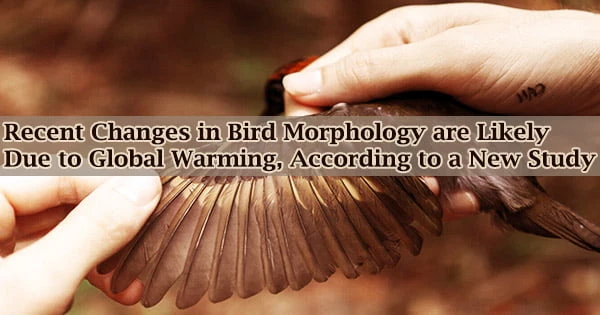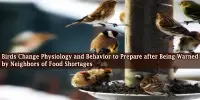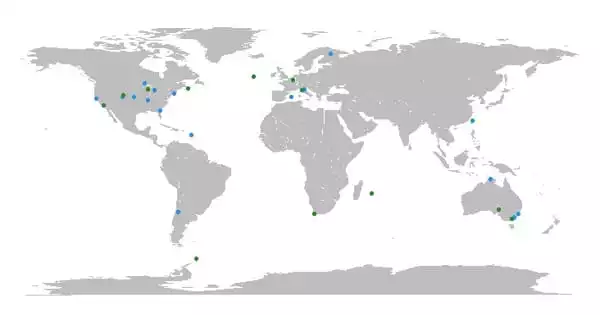Tel Aviv University researchers discovered alterations in the morphology of several birds in Israel during the last 70 years, which they believe are a result of climate change. Some species’ body mass declined, while others’ body length rose, increasing the ratio of surface area to volume in both situations. According to the researchers, these are ways for facilitating heat loss to the environment.
The researchers: “The birds evidently changed in response to the changing climate. However, this solution may not be fully adequate, especially as temperatures continue to rise.”
Prof. Shai Meiri and Ph.D. student Shahar Dubiner of Tel Aviv University’s School of Zoology, Wise Faculty of Life Sciences, and Steinhardt Museum of Natural History led the research. Global Ecology and Biogeography is the scholarly publication where the paper was published.
Bergmann’s rule, developed in the 19th century, states that members of bird and mammal species living in cold climates tend to be larger than members of the same species living in warmer climates.
This is due to the fact that the ratio of surface area to volume is higher in smaller animals, allowing for more heat escape (a benefit in hotter climes), and lower in larger animals, decreasing heat loss (a benefit in colder climates). The study of ecological morphology in birds necessitates the integration of data on evolutionary relationships across taxa as well as their environmental adaptations.
Comparisons of the size and shape of birds in different lineages that occupy the same microhabitat or comparisons of taxa that occupy similar but separate environments might reveal parallel or convergent morphological evolution.
Scientists have recently predicted that global warming will result in a reduction in animal size, with one possible exception: birds living in human environments (such as pigeons, house sparrows, and the hooded crow) may grow in size due to increased food availability, a phenomenon already seen in mammals such as jackals and wolves.
Our findings revealed a complicated picture. We identified two different types of morphological changes: some species had become lighter their mass had decreased while their body length remained unchanged; while others had become longer their body length had increased, while their mass remained unchanged. These together represent more than half of the species examined, but there was practically no overlap between the two groups almost none of the birds had become both lighter and longer.
Shahar Dubiner
The interpretation of morphological relationships among species in communities is more complicated. Many ostensibly regularities in coexisting species size ratios can’t be separated from randomly dispersed arrays of species sizes.
The researchers used the Steinhardt Museum of Natural History at TAU’s enormous bird collection to examine for changes in bird morphology over the past 70 years in Israel. They looked at 8,000 adult specimens of 106 different species, including migratory birds that pass through Israel every year (such as the common chiffchaff, white stork, and black buzzard), resident wild birds (such as the Eurasian jay, Eurasian eagle-owl, and rock partridge), and commensal birds (those that live near humans).
They created a complicated statistical model with multiple factors to evaluate morphological changes in the birds’ body mass, body length, and wing length over time. It’s unfortunate that the parallel between morphological links across species in a community and fitness peaks in various populations of a single species implies that communities evolve in lockstep.
Quantitative investigations of morphological links between coexisting species should take into account the species’ degrees of abundance and rarity across time.
Shahar Dubiner: “Our findings revealed a complicated picture. We identified two different types of morphological changes: some species had become lighter their mass had decreased while their body length remained unchanged; while others had become longer their body length had increased, while their mass remained unchanged. These together represent more than half of the species examined, but there was practically no overlap between the two groups almost none of the birds had become both lighter and longer.”
“We think that these are two different strategies for coping with the same problem, namely the rising temperatures. In both cases, the surface area to volume ratio is increased (by either increasing the numerator or reducing the denominator) which helps the body lose heat to its environment. The opposite, namely a decrease in this ratio, was not observed in any of the species.”
These findings were reported across the country, regardless of diet, and in a variety of species, including resident birds, commensal species living in the human environment, which, contrary to expectations, showed similar alterations to other birds, and migrants.
However, there was a distinction between the two strategies: migrants’ body length changes were more common, but non-migratory birds’ body mass changes were more common. The presence of such modifications in migratory birds from Asia, Europe, and Africa shows that we are witnessing a worldwide occurrence.
The study also discovered that the influence of climate change on avian morphology over time is ten times greater than the impact of equivalent temperature fluctuations across geographical areas.
Shahar Dubiner: “Our findings indicate that global warming causes fast and significant changes in bird morphology. But what are the implications of these changes? Should we be concerned? Is this a problem, or rather an encouraging ability to adapt to a changing environment?”
“Such morphological changes over a few decades probably do not represent an evolutionary adaptation, but rather certain phenotypic flexibility exhibited by the birds. We are concerned that over such a short period of time, there is a limit to the flexibility or evolutionary potential of these traits, and the birds might run out of effective solutions as temperatures continue to rise.”
















